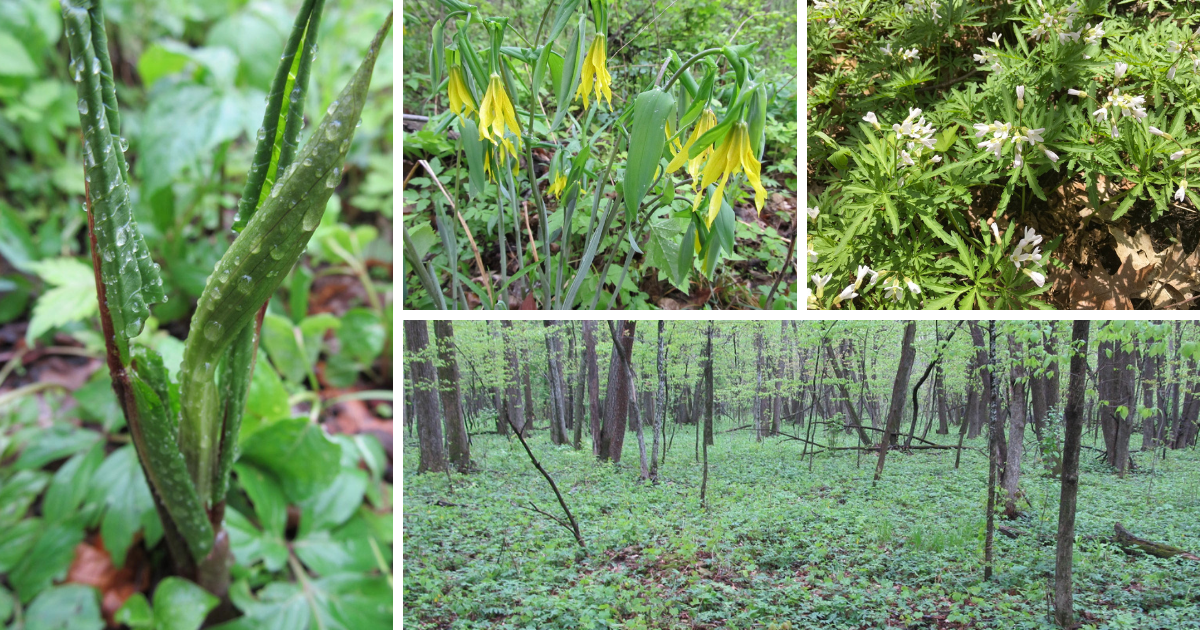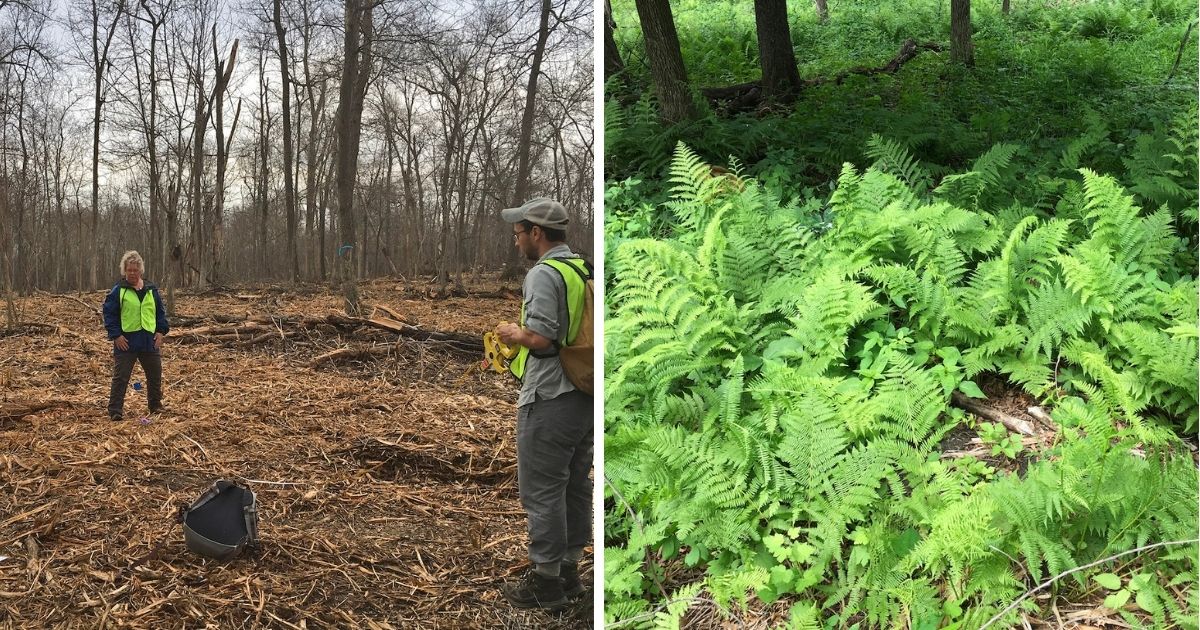How can we reduce buckthorn and preserve native plants? The results are in!
After we remove dense stands of buckthorn by mowing (left), native woodland plants have a chance to regenerate (right).
FMR has worked to restore over 2,000 acres of habitat and natural areas of all sizes in the Mississippi River's metro watershed. In addition to managing restorations, we study our project areas and practices to gauge our impact and refine our methods.
In 2018, we started a three-year research project at Hampton Woods Wildlife Management Area (WMA) to find out how different buckthorn control methods best protect and encourage native plants. Now the results are in!
We've enjoyed sharing these findings with fellow habitat restorers and researchers and thought our members, volunteers and other supporters might appreciate a behind-the-scenes glimpse into the field.
Our research setup
The only forest among miles of farmland in all directions, Hampton Woods WMA is a 200-acre haven for wood thrush, ovenbirds and other woodland wildlife in Dakota County.

Hampton Woods WMA from the sky — This land is part of a larger conservation and restoration strategy to improve wildlife habitat along the Vermillion River, an important tributary of the Mississippi River. Learn more about habitat corridors in this video. (Photo by Tom Reiter for FMR)
To restore its woodlands, we're removing buckthorn to make way for more plant diversity and more resilient habitat.
Removing buckthorn is a standard restoration activity, but approaches to it vary, and there are surprisingly few studies that directly compare and contrast them.
Our goal: Pit a newer method, forestry mowing, against the standard approach of cutting and treating each buckthorn stem by hand.
Both processes frequently use herbicides, and although chemicals are carefully applied when most native plants are dormant, we were concerned about their potential effect on nearby native plant communities. We wanted to compare the impact of four variations of these methods on native species.
We also wanted to assess whether we could get sufficient buckthorn control without using herbicide. (From using goats to holding dozens of volunteer events with hundreds of restoration volunteers annually, we aim to minimize the use of herbicides. But when it benefits the health of our Twin Cities metro area prairies and forests, we do support their selective, highly targeted and judicious use.)
So our study had two purposes: to see how effectively each method eliminated buckthorn and to better understand the effect of each treatment on native plants.
With funding from Dakota County and in cooperation with the Minnesota Department of Natural Resources, we set up four 5-acre plots (Units) at Hampton Woods WMA to test our different removal methods:
- Unit 1: Forestry mowing during winter dormancy, plus stump treatment on large-diameter stems, followed by a fall herbicide application to resprouts and new stems
- Unit 2: Forestry mowing during winter dormancy, no stump treatment, followed by a fall herbicide application to resprouts and new stems
- Unit 3: Forestry mowing during winter dormancy in two consecutive years, no herbicide treatment
- Unit 4: Hand-cutting and stump treatment on stems during winter dormancy, with no additional follow-up
Read more about the study setup.
What we found out
The results of our experiment were mixed. No single unit had both the highest buckthorn control and the lowest impact on native plants. Here's how each turned out:
- Unit 1: second-best buckthorn control, but the most negative effect on native plant richness and cover
- Unit 2: best buckthorn control and good native plant richness and cover
- Units 3 and 4: least buckthorn control, but highest native plant richness and cover (slightly better than Unit 2)
All methods reduced buckthorn and the number of native plants. Overall, we felt that the technique we used in Unit 2 was the best, with the greatest buckthorn control and only moderate negative impacts on native plants.
We were surprised to discover that the area of Hampton Woods where we conducted our study turned out to be less degraded than we thought. Initially, the buckthorn formed a thick shrub layer of large mature plants, up to 25 feet tall. The foliage was so dense that little light reached through, and the ground was mostly bare.
However, once the buckthorn was removed, a flush of native plants regenerated, especially in the second year. In fact, besides buckthorn, very few non-native plants returned after we removed buckthorn. This is a significant success for our restoration but unexpected for our experiment. Such immediate regeneration across the board is rare, so our results may be less transferable to other sites.
But there's still a lot to take away about mowing practices and procedures from our results, especially for land managers. Read our full report.

Removing buckthorn opens up space for plant diversity. At Hampton Woods WMA, we've spotted native woodland plants like Jack-in-the-pulpit, large-flowered bellwort and cutleaf toothwort.
What this means for our restoration practices
We've already applied these results and other practices to some of our restoration sites.
We now pre-cut and stump-treat large buckthorn stems (over 2-inches diameter at chest height) before forestry mowing. Very large stems have a lot of energy reserves, resprout vigorously, and are difficult to kill with foliar (leaf) application, so it can take multiple treatments to control the buckthorn.
We follow up the initial removal with a fall foliar treatment once native plants are dormant. This helps us target only the still-active buckthorn. We then wait a season and conduct a prescribed burn if possible. Depending on the site we typically seed with native woodland grasses and flowers after the burn to help provide groundcover, suppress buckthorn seedlings and allow for future prescribed burning.
It's clear that even when herbicides are applied during fall dormancy, there can be collateral damage to dormant plants. We need to continue to seek control methods that minimize herbicide application. When treating stumps, we currently require dauber or foam applicators to ensure that no overspray could touch non-target plants. We are also now exploring using a wick application for buckthorn resprouts, which is sort of like using a paint roller that touches the target plants but doesn't spray beyond them.
Of course, more studies are needed. Every site is different, so no one method will apply to every site; the same process could have dramatically different results in different places. These are the nuances of the restoration field and why ecologists constantly monitor and apply adaptive management methods.
Learn more and get involved
Join us! Over a thousand people a year volunteer to restore habitat and learn about invasive species like buckthorn annually with FMR staff. Sign up for Mississippi Messages to receive river news and monthly event calendars, or email volunteer@fmr.org to learn more.
Thanks to our partners and funders
Thanks to the Dakota County Land Conservation program for their financial support to conduct this study. Funding support for subcontractor work was also proved by the Outdoor Heritage Fund of the Minnesota Land and Water Legacy Amendment. And thanks to the Minnesota Department of Natural Resources for enabling us to do the restoration project and study at Hampton Woods WMA.
